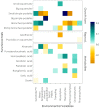Morphological and Chemical Traits of Cladonia Respond to Multiple Environmental Factors in Acidic Dry Grasslands
- PMID: 33671558
- PMCID: PMC7926809
- DOI: 10.3390/microorganisms9020453
Morphological and Chemical Traits of Cladonia Respond to Multiple Environmental Factors in Acidic Dry Grasslands
Abstract
Terricolous lichen communities in lowlands occur especially in open dry habitats. Such communities are often dominated by species of the genus Cladonia, which are very variable in morphology, reproduction strategies, and secondary metabolites. In this work, we investigated traits-environment relationships considering vegetation dynamics, substrate pH, disturbance, and climate. A total of 122 plots were surveyed in 41 acidic dry grasslands in the western Po Plain (Northern Italy). Relationships between Cladonia traits and environmental variables were investigated by means of a model-based Fourth Corner Analysis. Thallus morphology and metabolites responded to vegetation dynamics, substrate pH, disturbance, and climate, whereas reproduction strategies responded only to vegetation dynamics. Traits' correlations with vegetation dynamics elucidate their colonization patterns in open dry habitats or suggest biotic interactions with bryophytes and vascular plants. In addition, correlations between metabolites and environmental factors support interpretations of their ecological roles. Our results also stress the importance of studying traits' relationships with climatic factors as an alert towards lichen reactions to climate change.
Keywords: lichens; open dry habitats; reproduction strategy; secondary metabolites; species traits; thallus growth forms; vegetation dynamics.
Conflict of interest statement
The authors declare no conflict of interest.
Figures
References
-
- Nimis P.L., Martellos S., Chiarucci A., Ongaro S., Peplis M., Pittao E., Nascimbene J. Exploring the Relationships between Ecology and Species Traits in Cyanolichens: A Case Study on Italy. Fungal Ecol. 2020;47:100950. doi: 10.1016/j.funeco.2020.100950. - DOI
-
- Saiz H., Dainese M., Chiarucci A., Nascimbene J. Networks of Epiphytic Lichens and Host Trees along Elevation Gradients: Climate Change Implications in Mountain Ranges. J. Ecol. 2020 doi: 10.1111/1365-2745.13538. - DOI
-
- Giordani P., Brunialti G., Bacaro G., Nascimbene J. Functional Traits of Epiphytic Lichens as Potential Indicators of Environmental Conditions in Forest Ecosystems. Ecol. Indic. 2012;18:413–420. doi: 10.1016/j.ecolind.2011.12.006. - DOI
-
- Jüriado I., Paal J. Epiphytic Lichen Synusiae and Functional Trait Groups in Boreo-Nemoral Deciduous Forests Are Influenced by Host Tree and Environmental Factors. Nord. J. Bot. 2019;37:e01939. doi: 10.1111/njb.01939. - DOI
-
- Hurtado P., Prieto M., Martínez-Vilalta J., Giordani P., Aragón G., López-Angulo J., Košuthová A., Merinero S., Díaz-Peña E.M., Rosas T., et al. Disentangling Functional Trait Variation and Covariation in Epiphytic Lichens along a Continent-Wide Latitudinal Gradient. Proc. R. Soc. B. 2020;287:20192862. doi: 10.1098/rspb.2019.2862. - DOI - PMC - PubMed
LinkOut - more resources
Full Text Sources
Other Literature Sources



